Stewart J. Calculus
Подождите немного. Документ загружается.


EXAMPLE 6 If the joint density function for X and Y is given by
find the value of the constant C. Then find .
SOLUTION We find the value of C by ensuring that the double integral of f is equal to 1.
Because outside the rectangle , we have
Therefore and so .
Now we can compute the probability that X is at most 7 and Y is at least 2:
M
Suppose X is a random variable with probability density function and Y is a ran-
dom variable with density function . Then X and Y are called independent random
variables if their joint density function is the product of their individual density functions:
In Section 9.5 we modeled waiting times by using exponential density functions
where is the mean waiting time. In the next example we consider a situation with two
independent waiting times.
EXAMPLE 7 The manager of a movie theater determines that the average time movie-
goers wait in line to buy a ticket for this week’s film is 10 minutes and the average time
they wait to buy popcorn is 5 minutes. Assuming that the waiting times are independent,
find the probability that a moviegoer waits a total of less than 20 minutes before taking
his or her seat.
SOLUTION Assuming that both the waiting time X for the ticket purchase and the waiting
time Y in the refreshment line are modeled by exponential probability density functions,
we can write the individual density functions as
f
2
共y兲 苷
再
0
1
5
e
y兾5
if y
0
if y 0
f
1
共x兲 苷
再
0
1
10
e
x兾10
if x
0
if x 0
f 共t兲 苷
再
0
1
e
t兾
if t
0
if t 0
f 共x, y兲 苷 f
1
共x兲 f
2
共y兲
f
2
共y兲
f
1
共x兲
苷
868
1500
⬇ 0.5787
苷
1
1500
y
7
0
[
xy y
2
]
y苷2
y苷10
dx 苷
1
1500
y
7
0
共8x 96兲 dx
P共X 7, Y 2兲 苷
y
7
y
2
f 共x, y兲 dy dx 苷
y
7
0
y
10
2
1
1500
共x 2y兲 dy dx
C 苷
1
1500
1500C 苷 1
苷 C
y
10
0
共10x 100兲 dx 苷 1500C
y
y
f 共x, y兲 dy dx 苷
y
10
0
y
10
0
C共x 2y兲 dy dx 苷 C
y
10
0
[
xy y
2
]
y苷0
y苷10
dx
关0, 10兴 关0, 10兴f 共x, y兲 苷 0
P共X 7, Y 2兲
f 共x, y兲 苷
再
0
C共x 2y兲
otherwise
if 0 x 10, 0 y 10
1022
||||
CHAPTER 16 MULTIPLE INTEGRALS
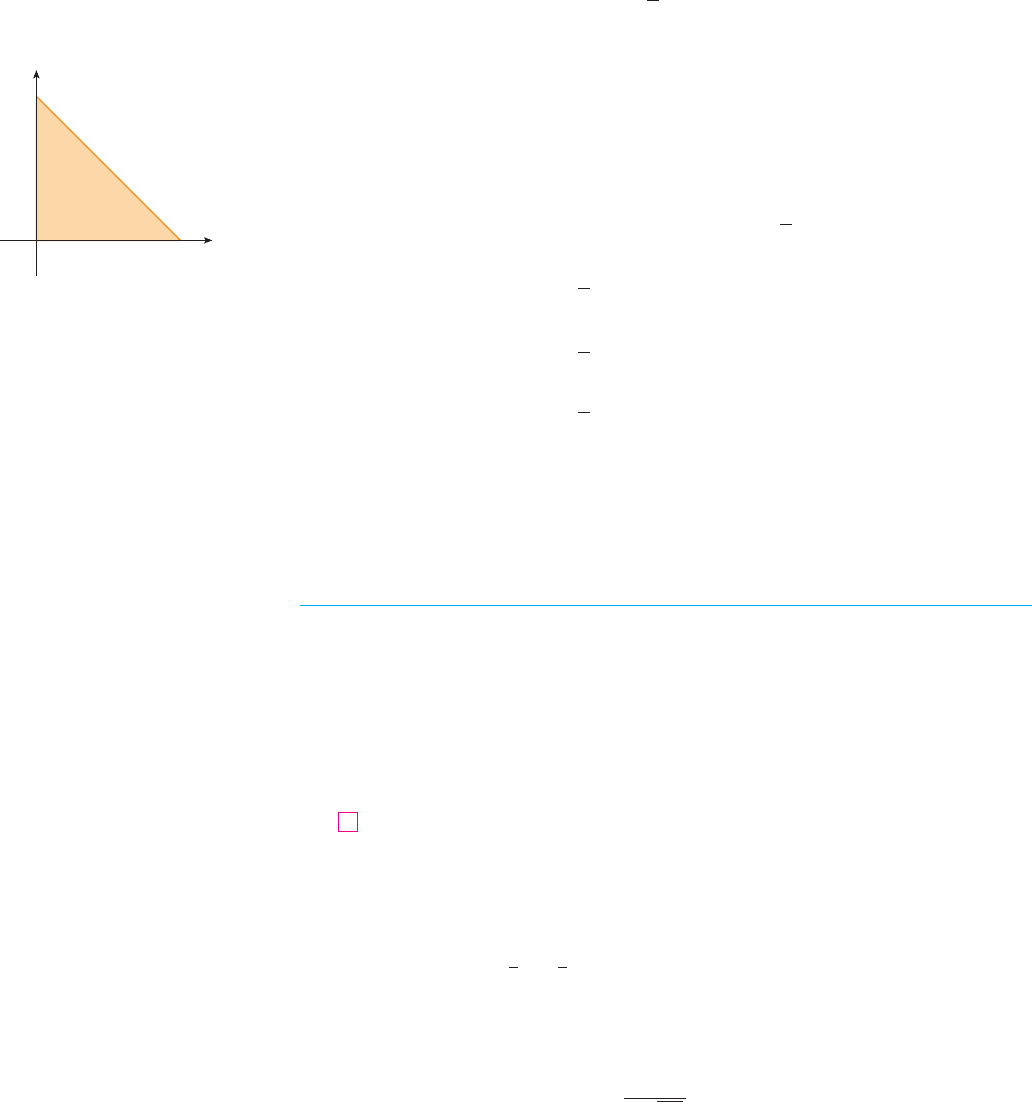
Since X and Y are independent, the joint density function is the product:
We are asked for the probability that :
where D is the triangular region shown in Figure 8. Thus
This means that about 75% of the moviegoers wait less than 20 minutes before taking
their seats.
M
EXPECTED VALUES
Recall from Section 9.5 that if X is a random variable with probability density function
then its mean is
Now if X and Y are random variables with joint density function f, we define the X-mean
and Y-mean, also called the expected values of X and Y, to be
Notice how closely the expressions for and in (11) resemble the moments and
of a lamina with density function in Equations 3 and 4. In fact, we can think of proba-
bility as being like continuously distributed mass. We calculate probability the way we cal-
culate mass—by integrating a density function. And because the total “probability mass”
is 1, the expressions for and in (5) show that we can think of the expected values of X
and Y, and , as the coordinates of the “center of mass” of the probability distribution.
In the next example we deal with normal distributions. As in Section 9.5, a single ran-
dom variable is normally distributed if its probability density function is of the form
where is the mean and is the standard deviation.
f 共x兲 苷
1
s
2
e
共x
兲
2
兾共2
2
兲
2
1
yx
M
y
M
x
2
1
2
苷
yy
⺢
2
yf共x, y兲 dA
1
苷
yy
⺢
2
xf共x, y兲 dA
11
苷
y
xf共x兲 dx
f,
苷 1 e
4
2e
2
⬇ 0.7476
苷
1
10
y
20
0
共e
x兾10
e
4
e
x兾10
兲
dx
苷
1
10
y
20
0
e
x兾10
共1 e
共x20兲兾5
兲
dx
苷
1
50
y
20
0
[
e
x兾10
共5兲e
y兾5
]
y苷0
y苷20x
dx
P共X Y
20兲 苷
yy
D
f 共x,
y兲
dA 苷
y
20
0
y
20x
0
1
50
e
x兾10
e
y兾5
dy dx
P共X Y
20兲 苷 P共共X, Y 兲 僆 D兲
X Y
20
f 共x, y兲 苷 f
1
共x兲 f
2
共y兲 苷
再
1
50
e
x兾10
e
y兾5
0
if x 0, y 0
otherwise
SECTION 16.5 APPLICATIONS OF DOUBLE INTEGRALS
||||
1023
FIGURE 8
20
20
D
0
y
x
x+y=20
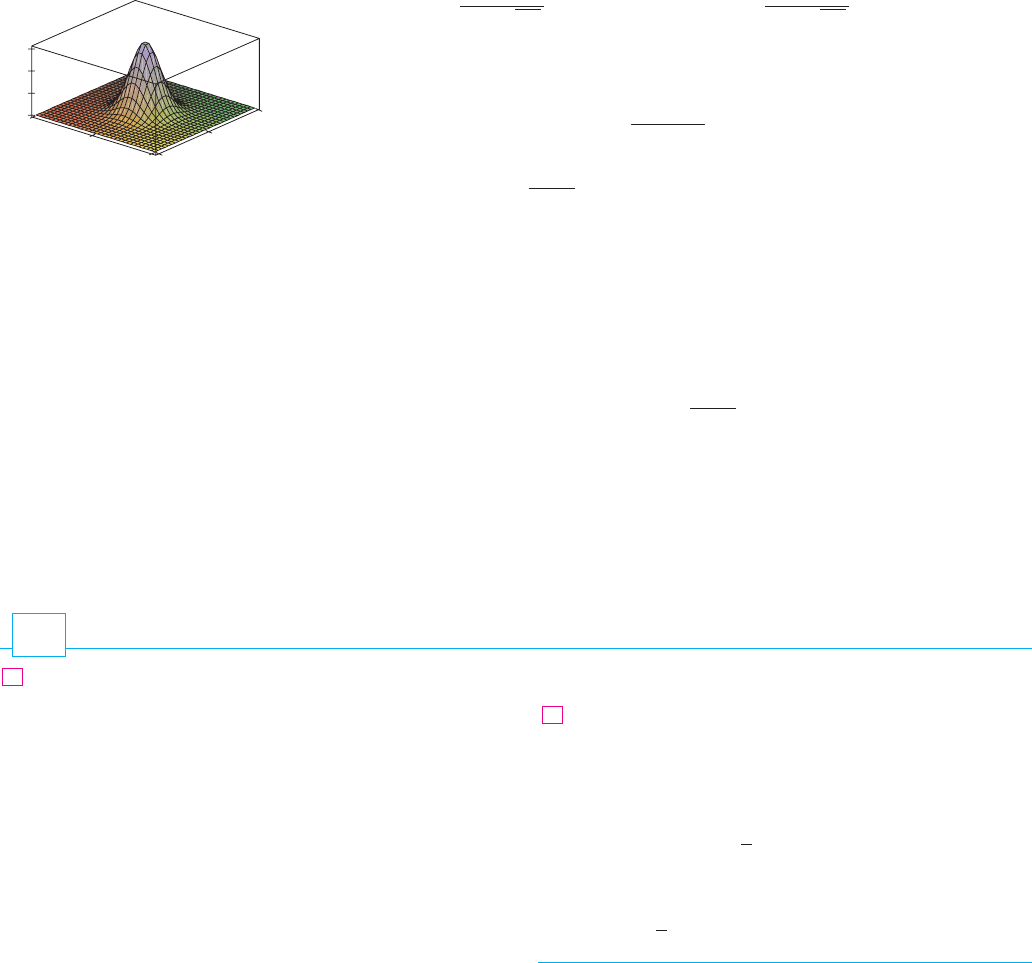
EXAMPLE 8 A factory produces (cylindrically shaped) roller bearings that are sold as
having diameter 4.0 cm and length 6.0 cm. In fact, the diameters X are normally distrib-
uted with mean 4.0 cm and standard deviation 0.01 cm while the lengths Y are normally
distributed with mean 6.0 cm and standard deviation 0.01 cm. Assuming that X and Y are
independent, write the joint density function and graph it. Find the probability that a
bearing randomly chosen from the production line has either length or diameter that
differs from the mean by more than 0.02 cm.
SOLUTION We are given that X and Y are normally distributed with , and
. So the individual density functions for X and Y are
Since X and Y are independent, the joint density function is the product:
A graph of this function is shown in Figure 9.
Let’s first calculate the probability that both X and Y differ from their means by less
than 0.02 cm. Using a calculator or computer to estimate the integral, we have
Then the probability that either X or Y differs from its mean by more than 0.02 cm is
approximately
M
1 0.91 苷 0.09
⬇ 0.91
苷
5000
y
4.02
3.98
y
6.02
5.98
e
5000关共x4兲
2
共 y6兲
2
兴
dy dx
P共3.98
X
4.02, 5.98
Y
6.02兲 苷
y
4.02
3.98
y
6.02
5.98
f 共x, y兲 dy dx
苷
5000
e
5000关共x4兲
2
共 y6兲
2
兴
f 共x, y兲 苷 f
1
共x兲 f
2
共y兲 苷
1
0.0002
e
共x4兲
2
兾0.0002
e
共y6兲
2
兾0.0002
f
2
共y兲 苷
1
0.01
s
2
e
共 y6兲
2
兾0.0002
f
1
共x兲 苷
1
0.01
s
2
e
共x4兲
2
兾0.0002
1
苷
2
苷 0.01
2
苷 6.0,
1
苷 4.0
1024
||||
CHAPTER 16 MULTIPLE INTEGRALS
FIGURE 9
Graph of the bivariate normal joint
density function in Example 8
1500
1000
500
0
y
6.05
6
5.95
x
4.05
4
3.95
4. ;
is the triangular region with vertices , , ;
6. is the triangular region enclosed by the lines , ,
and ;
7. is bounded by , , , and ;
8. is bounded by , , and ;
9. ;
10. is bounded by the parabolas and ;
共x, y兲 苷
s
x
x 苷 y
2
y 苷 x
2
D
共x, y兲 苷 yD 苷 兵共x, y兲
ⱍ
0 y sin共
x兾L兲, 0 x L其
共x, y兲 苷 xx 苷 1y 苷 0y 苷
s
x
D
共x, y兲 苷 yx 苷 1x 苷 0y 苷 0y 苷 e
x
D
共x, y兲 苷 x
2
2x y 苷 6
y 苷 xx 苷 0D
共x, y兲 苷 x y
共0, 3兲共2, 1兲共0, 0兲D
5.
共x, y兲 苷 cxyD 苷 兵共x, y兲
ⱍ
0 x a, 0 y b其
Electric charge is distributed over the rectangle ,
so that the charge density at is
(measured in coulombs per square meter).
Find the total charge on the rectangle.
2. Electric charge is distributed over the disk so
that the charge density at is
(measured in coulombs per square meter). Find the total charge
on the disk.
3–10 Find the mass and center of mass of the lamina that occupies
the region and has the given density function .
3. ;
共x, y兲 苷 xy
2
D 苷 兵共x, y兲
ⱍ
0 x 2, 1 y 1其
D
共x, y兲 苷 x y x
2
y
2
共x, y兲
x
2
y
2
4
共x, y兲 苷 2xy y
2
共x, y兲0 y 2
1 x 3
1.
EXERCISES
16.5

The joint density function for a pair of random variables
and is
(a) Find the value of the constant .
(b) Find .
(c) Find .
28. (a) Verify that
is a joint density function.
(b) If and are random variables whose joint density func-
tion is the function in part (a), find
(i) (ii)
(c) Find the expected values of and .
Suppose and are random variables with joint density
function
(a) Verify that is indeed a joint density function.
(b) Find the following probabilities.
(i) (ii)
(c) Find the expected values of and .
30. (a) A lamp has two bulbs of a type with an average lifetime
of 1000 hours. Assuming that we can model the proba-
bility of failure of these bulbs by an exponential density
function with mean , find the probability that
both of the lamp’s bulbs fail within 1000 hours.
(b) Another lamp has just one bulb of the same type as in
part (a). If one bulb burns out and is replaced by a bulb
of the same type, find the probability that the two bulbs
fail within a total of 1000 hours.
31. Suppose that and are independent random variables,
where is normally distributed with mean 45 and standard
deviation 0.5 and is normally distributed with mean 20 and
standard deviation 0.1.
(a) Find .
(b) Find .
32. Xavier and Yolanda both have classes that end at noon and
they agree to meet every day after class. They arrive at the
coffee shop independently. Xavier’s arrival time is and
Yolanda’s arrival time is , where and are measured in
minutes after noon. The individual density functions are
(Xavier arrives sometime after noon and is more likely to
arrive promptly than late. Yolanda always arrives by 12:10
PM
and is more likely to arrive late than promptly.) After Yolanda
arrives, she’ll wait for up to half an hour for Xavier, but he
won’t wait for her. Find the probability that they meet.
f
2
共y兲 苷
再
1
50
y
0
if 0 y 10
otherwise
f
1
共x兲 苷
再
e
x
0
if x 0
if x
0
YXY
X
P共4共X 45兲
2
100共Y 20兲
2
2兲
P共40 X 50, 20 Y 25兲
Y
X
YX
CAS
苷 1000
YX
P共X 2, Y 4兲P共Y 1兲
f
f 共x, y兲 苷
再
0.1e
共0.5x0.2y兲
0
if x 0, y 0
otherwise
YX
29.
YX
P
(
X
1
2
, Y
1
2
)
P
(
X
1
2
)
f
YX
f 共x, y兲 苷
再
4xy
0
if 0 x 1, 0 y 1
otherwise
P共X Y 1兲
P共X 1, Y 1兲
C
f 共x, y兲 苷
再
Cx共1 y兲
0
if 0 x 1, 0 y 2
otherwise
Y
X
27.
11. A lamina occupies the part of the disk in the
first quadrant. Find its center of mass if the density at any
point is proportional to its distance from the -axis.
12. Find the center of mass of the lamina in Exercise 11 if the
density at any point is proportional to the square of its
distance from the origin.
13. The boundary of a lamina consists of the semicircles
and together with the portions
of the -axis that join them. Find the center of mass of the
lamina if the density at any point is proportional to its dis-
tance from the origin.
14. Find the center of mass of the lamina in Exercise 13 if the
density at any point is inversely proportional to its distance
from the origin.
Find the center of mass of a lamina in the shape of an isos-
celes right triangle with equal sides of length if the density
at any point is proportional to the square of the distance from
the vertex opposite the hypotenuse.
16. A lamina occupies the region inside the circle
but outside the circle . Find the center of mass
if the density at any point is inversely proportional to its dis-
tance from the origin.
17. Find the moments of inertia , , for the lamina of
Exercise 7.
18. Find the moments of inertia , , for the lamina of
Exercise 12.
19. Find the moments of inertia , , for the lamina of
Exercise 15.
20. Consider a square fan blade with sides of length 2 and the
lower left corner placed at the origin. If the density of the
blade is , is it more difficult to rotate the
blade about the -axis or the -axis?
21– 22 Use a computer algebra system to find the mass, center
of mass, and moments of inertia of the lamina that occupies the
region and has the given density function.
21. ;
22. is enclosed by the cardioid ;
23–26 A lamina with constant density occupies the
given region. Find the moments of inertia and and the radii
of gyration and .
23. The rectangle
24. The triangle with vertices , , and
25. The part of the disk in the first quadrant
26. The region under the curve from to
x 苷
x 苷 0y 苷 sin x
x
2
y
2
a
2
共0, h兲共b, 0兲共0, 0兲
0 x b, 0 y h
y
x
I
y
I
x
共x, y兲 苷
CAS
共x, y兲 苷
s
x
2
y
2
r 苷 1 cos
D
共x, y兲 苷 xyD 苷 兵共x, y兲
ⱍ
0 y sin x,0 x
其
D
CAS
yx
共x, y兲 苷 1 0.1x
I
0
I
y
I
x
I
0
I
y
I
x
I
0
I
y
I
x
x
2
y
2
苷 1
x
2
y
2
苷 2y
a
15.
x
y 苷
s
4 x
2
y 苷
s
1 x
2
x
x
2
y
2
1
SECTION 16.5 APPLICATIONS OF DOUBLE INTEGRALS
||||
1025

1026
||||
CHAPTER 16 MULTIPLE INTEGRALS
(a) Suppose the exposure of a person to the disease is the
sum of the probabilities of catching the disease from all
members of the population. Assume that the infected
people are uniformly distributed throughout the city, with
infected individuals per square mile. Find a double
integral that represents the exposure of a person residing
at .
(b) Evaluate the integral for the case in which is the center
of the city and for the case in which is located on the
edge of the city. Where would you prefer to live?
A
A
A
k
33. When studying the spread of an epidemic, we assume that the
probability that an infected individual will spread the disease to
an uninfected individual is a function of the distance between
them. Consider a circular city of radius 10 mi in which the
population is uniformly distributed. For an uninfected indi-
vidual at a fixed point , assume that the probability
function is given by
where denotes the distance between and .APd共P, A兲
f 共P兲 苷
1
20
关20 d共P, A兲兴
A共x
0
, y
0
兲
TRIPLE INTEGRALS
Just as we defined single integrals for functions of one variable and double integrals for
functions of two variables, so we can define triple integrals for functions of three variables.
Let’s first deal with the simplest case where is defined on a rectangular box:
The first step is to divide B into sub-boxes. We do this by dividing the interval into
l subintervals of equal width , dividing into m subintervals of width ,
and dividing into n subintervals of width . The planes through the endpoints of
these subintervals parallel to the coordinate planes divide the box into sub-boxes
which are shown in Figure 1. Each sub-box has volume .
Then we form the triple Riemann sum
where the sample point is in . By analogy with the definition of a double
integral (16.1.5), we define the triple integral as the limit of the triple Riemann sums in (2).
DEFINITION The triple integral of over the box is
if this limit exists.
Again, the triple integral always exists if is continuous. We can choose the sample
point to be any point in the sub-box, but if we choose it to be the point we get a
simpler-looking expression for the triple integral:
Just as for double integrals, the practical method for evaluating triple integrals is to
express them as iterated integrals as follows.
yyy
B
f 共x, y, z兲 dV 苷 lim
l, m, n l
兺
l
i苷1
兺
m
j苷1
兺
n
k苷1
f 共x
i
, y
j
, z
k
兲 V
共x
i
, y
j
, z
k
兲
f
yyy
B
f 共x, y, z兲 dV 苷 lim
l, m, n l
兺
l
i苷1
兺
m
j苷1
兺
n
k苷1
f 共x
ijk
*
, y
ijk
*
, z
ijk
*
兲 V
Bf
3
B
ijk
共x
ijk
*
, y
ijk
*
, z
ijk
*
兲
兺
l
i苷1
兺
m
j苷1
兺
n
k苷1
f 共x
ij k
*
, y
ijk
*
, z
ijk
*
兲 V
2
V 苷 x y z
B
ijk
苷 关x
i1
, x
i
兴 关y
j1
, y
j
兴 关z
k1
, z
k
兴
lmnB
z关r, s兴
y关c, d 兴x关x
i1
, x
i
兴
关a, b兴
B 苷
兵
共x, y, z兲
ⱍ
a x b, c y d, r z s
其
1
f
16.6
FIGURE 1
B
B
ijk
Îx
Îy
Îz
z
y
x
z
y
x
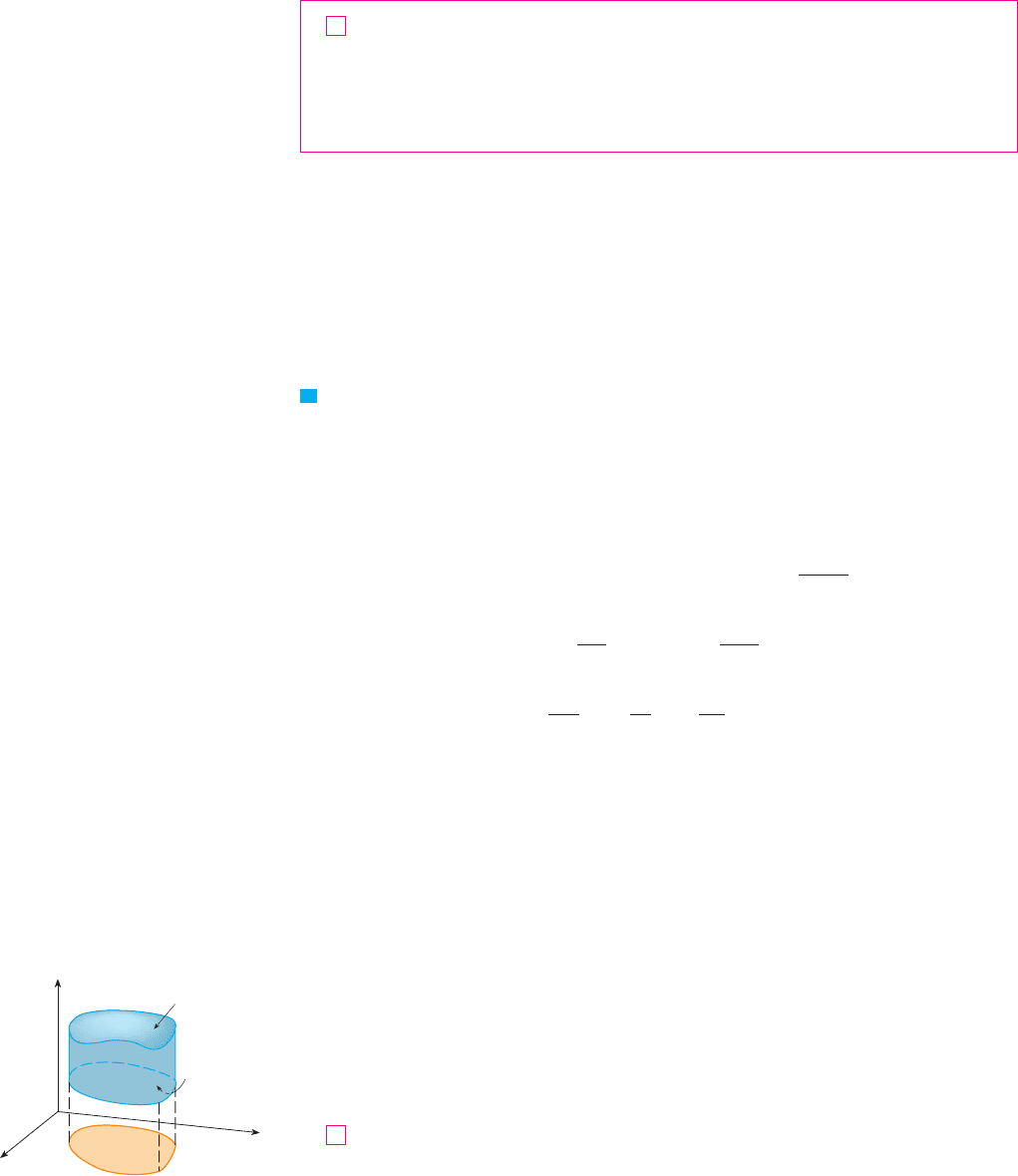
FUBINI’S THEOREM FOR TRIPLE INTEGRALS If is continuous on the rectan-
gular box , then
The iterated integral on the right side of Fubini’s Theorem means that we integrate first
with respect to (keeping and fixed), then we integrate with respect to (keeping
fixed), and finally we integrate with respect to . There are five other possible orders in
which we can integrate, all of which give the same value. For instance, if we integrate with
respect to , then , and then , we have
EXAMPLE 1 Evaluate the triple integral , where is the rectangular box
given by
SOLUTION We could use any of the six possible orders of integration. If we choose to
integrate with respect to , then , and then , we obtain
M
Now we define the triple integral over a general bounded region E in three-
dimensional space (a solid) by much the same procedure that we used for double integrals
(16.3.2). We enclose in a box of the type given by Equation 1. Then we define a
function so that it agrees with on but is 0 for points in that are outside . By
definition,
This integral exists if is continuous and the boundary of is “reasonably smooth.” The
triple integral has essentially the same properties as the double integral (Properties 6–9 in
Section 16.3).
We restrict our attention to continuous functions and to certain simple types of regions.
A solid region is said to be of type 1 if it lies between the graphs of two continuous func-
tions of and , that is,
where is the projection of onto the -plane as shown in Figure 2. Notice that the
upper boundary of the solid is the surface with equation , while the lower
boundary is the surface .z 苷 u
1
共x, y兲
z 苷 u
2
共x, y兲E
xyED
E 苷
兵
共x, y, z兲
ⱍ
共x, y兲 僆 D, u
1
共x, y兲 z u
2
共x, y兲
其
5
yx
E
f
Ef
yyy
E
f 共x, y, z兲 dV 苷
yyy
B
F共x, y, z兲 dV
EBEfF
BE
苷
y
3
0
3z
2
4
dz 苷
z
3
4
册
0
3
苷
27
4
苷
y
3
0
y
2
1
yz
2
2
dy dz 苷
y
3
0
冋
y
2
z
2
4
册
y苷1
y苷2
dz
yyy
B
xyz
2
dV 苷
y
3
0
y
2
1
y
1
0
xyz
2
dx dy dz 苷
y
3
0
y
2
1
冋
x
2
yz
2
2
册
x苷0
x苷1
dy dz
zyx
B 苷
兵
共x, y, z兲
ⱍ
0 x 1, 1 y 2, 0 z 3
其
Bxxx
B
xyz
2
dV
V
yyy
B
f 共x, y, z兲 dV 苷
y
b
a
y
s
r
y
d
c
f 共x, y, z兲 dy dz dx
xzy
z
zyzyx
yyy
B
f 共x, y, z兲 dV 苷
y
s
r
y
d
c
y
b
a
f 共x, y, z兲 dx dy dz
B 苷 关a, b兴 关c, d兴 关r, s兴
f
4
SECTION 16.6 TRIPLE INTEGRALS
||||
1027
FIGURE 2
A type 1 solid region
z
0
x
y
D
E
z=u™(x,y)
z=u¡(x,y)
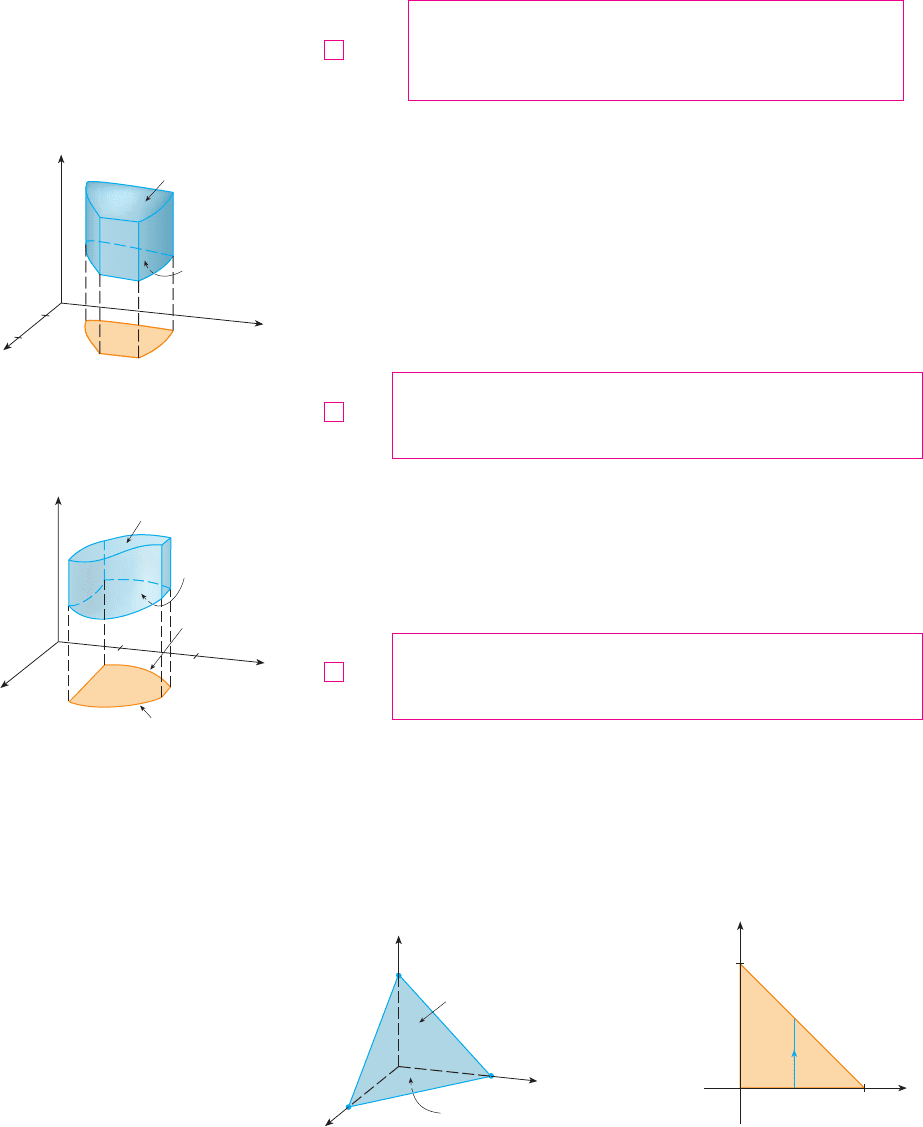
By the same sort of argument that led to Formula 16.3.3, it can be shown that if is a
type 1 region given by Equation 5, then
The meaning of the inner integral on the right side of Equation 6 is that and are held
fixed, and therefore and are regarded as constants, while is inte-
grated with respect to .
In particular, if the projection of onto the -plane is a type I plane region (as in
Figure 3), then
and Equation 6 becomes
If, on the other hand, is a type II plane region (as in Figure 4), then
and Equation 6 becomes
EXAMPLE 2 Evaluate , where is the solid tetrahedron bounded by the four
planes , , , and .
SOLUTION When we set up a triple integral it’s wise to draw two diagrams: one of
the solid region (see Figure 5) and one of its projection on the -plane (see
Figure 6). The lower boundary of the tetrahedron is the plane and the upper
0
1
x
1
y=0
y=1-x
D
y
FIGURE 6
FIGURE 5
x
0
z
y
(1,0,0)
(0,1,0)
(0,0,1)
E
z=1-x-y
z=0
z 苷 0
xyDE
x y z 苷 1z 苷 0y 苷 0x 苷 0
E
xxx
E
z dV
yyy
E
f 共x, y, z兲 dV 苷
y
d
c
y
h
2
共 y兲
h
1
共 y兲
y
u
2
共x, y兲
u
1
共x, y兲
f 共x, y, z兲 dz dx dy
8
E 苷
兵
共x, y, z兲
ⱍ
c y d, h
1
共y兲 x h
2
共y兲, u
1
共x, y兲 z u
2
共x, y兲
其
D
yyy
E
f 共x, y, z兲 dV 苷
y
b
a
y
t
2
共x兲
t
1
共x兲
y
u
2
共x, y兲
u
1
共x, y兲
f 共x, y, z兲 dz dy dx
7
E 苷
兵
共x, y, z兲
ⱍ
a x b, t
1
共x兲 y t
2
共x兲, u
1
共x, y兲 z u
2
共x, y兲
其
xyED
z
f 共x, y, z兲u
2
共x, y兲u
1
共x, y兲
yx
yyy
E
f 共x, y, z兲 dV 苷
yy
D
冋y
u
2
共x, y兲
u
1
共x, y兲
f 共x, y, z兲 dz
册
dA
6
E
1028
||||
CHAPTER 16 MULTIPLE INTEGRALS
FIGURE 3
A type 1 solid region where the
projection D is a type I plane region
z=u™(x,y)
0
D
E
y=g™(x)
y=g¡(x)
z
y
x
a
b
z=u¡(x,y)
x
0
z
y
c
d
z=u™(x,y)
x=h™(y)
x=h¡(y)
z=u¡(x,y)
E
D
FIGURE 4
A type 1 solid region with a type II
projection
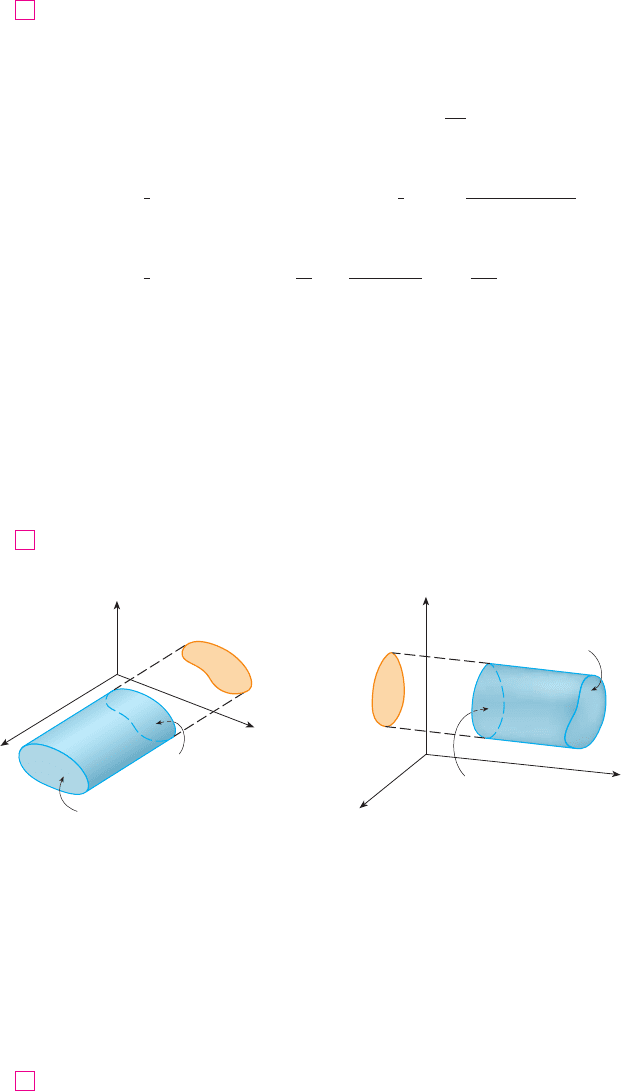
boundary is the plane (or ), so we use and
in Formula 7. Notice that the planes and
intersect in the line (or ) in the -plane. So the projection of is
the triangular region shown in Figure 6, and we have
This description of as a type 1 region enables us to evaluate the integral as follows:
M
A solid region is of type 2 if it is of the form
where, this time, is the projection of onto the -plane (see Figure 7). The back sur-
face is , the front surface is , and we have
Finally, a type 3 region is of the form
where is the projection of onto the -plane, is the left surface, and
is the right surface (see Figure 8). For this type of region we have
yyy
E
f 共x, y, z兲 dV 苷
yy
D
冋y
u
2
共x, z兲
u
1
共x, z兲
f 共x, y, z兲 dy
册
dA
11
y 苷 u
2
共x, z兲
y 苷 u
1
共x, z兲xzED
E 苷
兵
共x, y, z兲
ⱍ
共x, z兲 僆 D, u
1
共x, z兲 y u
2
共x, z兲
其
FIGURE 8 A type 3 region
z
y=u™(x,z)
y=u¡(x,z)
x
0
y
D
E
0
z
y
x
E
D
x=u¡(y,z)
x=u™(y,z)
FIGURE 7 A type 2 region
yyy
E
f 共x, y, z兲 dV 苷
yy
D
冋y
u
2
共 y, z兲
u
1
共 y, z兲
f 共x, y, z兲 dx
册
dA
10
x 苷 u
2
共y, z兲x 苷 u
1
共y, z兲
yzED
E 苷
兵
共x, y, z兲
ⱍ
共y, z兲 僆 D, u
1
共y, z兲 x u
2
共y, z兲
其
E
苷
1
6
y
1
0
共1 x兲
3
dx 苷
1
6
冋
共1 x兲
4
4
册
0
1
苷
1
24
苷
1
2
y
1
0
冋
共1 x y兲
3
3
册
y苷0
y苷1x
dx苷
1
2
y
1
0
y
1x
0
共1 x y兲
2
dy dx
苷
y
1
0
y
1x
0
冋
z
2
2
册
z苷0
z苷1xy
dy dx
yyy
E
z dV 苷
y
1
0
y
1x
0
y
1xy
0
z dz dy dx
E
E 苷
兵
共x, y, z兲
ⱍ
0 x 1, 0 y 1 x,0 z 1 x y
其
9
Exyy 苷 1 xx y 苷 1
z 苷 0x y z 苷 1u
2
共x, y兲 苷 1 x y
u
1
共x, y兲 苷 0z 苷 1 x yx y z 苷 1
SECTION 16.6 TRIPLE INTEGRALS
||||
1029

In each of Equations 10 and 11 there may be two possible expressions for the integral
depending on whether is a type I or type II plane region (and corresponding to Equa-
tions 7 and 8).
EXAMPLE 3 Evaluate , where is the region bounded by the parabo-
loid and the plane .
SOLUTION The solid is shown in Figure 9. If we regard it as a type 1 region, then we
need to consider its projection onto the -plane, which is the parabolic region in
Figure 10. (The trace of in the plane is the parabola .)
From we obtain , so the lower boundary surface of is
and the upper surface is . Therefore the description of as
a type 1 region is
and so we obtain
Although this expression is correct, it is extremely difficult to evaluate. So let’s
instead consider as a type 3 region. As such, its projection onto the -plane is the
disk shown in Figure 11.
Then the left boundary of is the paraboloid and the right boundary is
the plane , so taking and in Equation 11, we have
Although this integral could be written as
it’s easier to convert to polar coordinates in the -plane: , . This
gives
M
苷 2
冋
4r
3
3
r
5
5
册
0
2
苷
128
15
苷
y
2
0
y
2
0
共4 r
2
兲r r dr d
苷
y
2
0
d
y
2
0
共4r
2
r
4
兲 dr
yyy
E
s
x
2
z
2
dV 苷
yy
D
3
共4 x
2
z
2
兲
s
x
2
z
2
dA
z 苷 r sin
x 苷 r cos
xz
y
2
2
y
s
4x
2
s
4x
2
共4 x
2
z
2
兲
s
x
2
z
2
dz dx
苷
yy
D
3
共4 x
2
z
2
兲
s
x
2
z
2
dA
yyy
E
s
x
2
z
2
dV 苷
yy
D
3
冋y
4
x
2
z
2
s
x
2
z
2
dy
册
dA
u
2
共x, z兲 苷 4u
1
共x, z兲 苷 x
2
z
2
y 苷 4
y 苷 x
2
z
2
E
x
2
z
2
4
xzD
3
E
yy
E
y
s
x
2
z
2
dV 苷
y
2
2
y
4
x
2
y
s
yx
2
s
yx
2
s
x
2
z
2
dz dy dx
E 苷
兵
共x, y, z兲
ⱍ
2 x 2, x
2
y 4,
s
y x
2
z
s
y x
2
其
Ez 苷
s
y x
2
z 苷
s
y x
2
Ez 苷
s
y x
2
y 苷 x
2
z
2
FIGURE 9
Region of integration
0
4
y=≈+z@
E
x
z
y
y 苷 x
2
z 苷 0y 苷 x
2
z
2
xyD
1
E
y 苷 4y 苷 x
2
z
2
Exxx
E
s
x
2
z
2
dV
V
D
1030
||||
CHAPTER 16 MULTIPLE INTEGRALS
Visual 16.6 illustrates how solid
regions (including the one in Figure 9)
project onto coordinate planes.
TEC
FIGURE 11
Projection on xz-plane
x
0
z
≈+z@=4
_2 2
D£
|
The most difficult step in evaluating a triple
integral is setting up an expression for the region
of integration (such as Equation 9 in Example 2).
Remember that the limits of integration in the
inner integral contain at most two variables, the
limits of integration in the middle integral con-
tain at most one variable, and the limits of inte-
gration in the outer integral must be constants.
0
FIGURE 10
Projection on xy-plane
x
y
y=4
y=≈
D¡
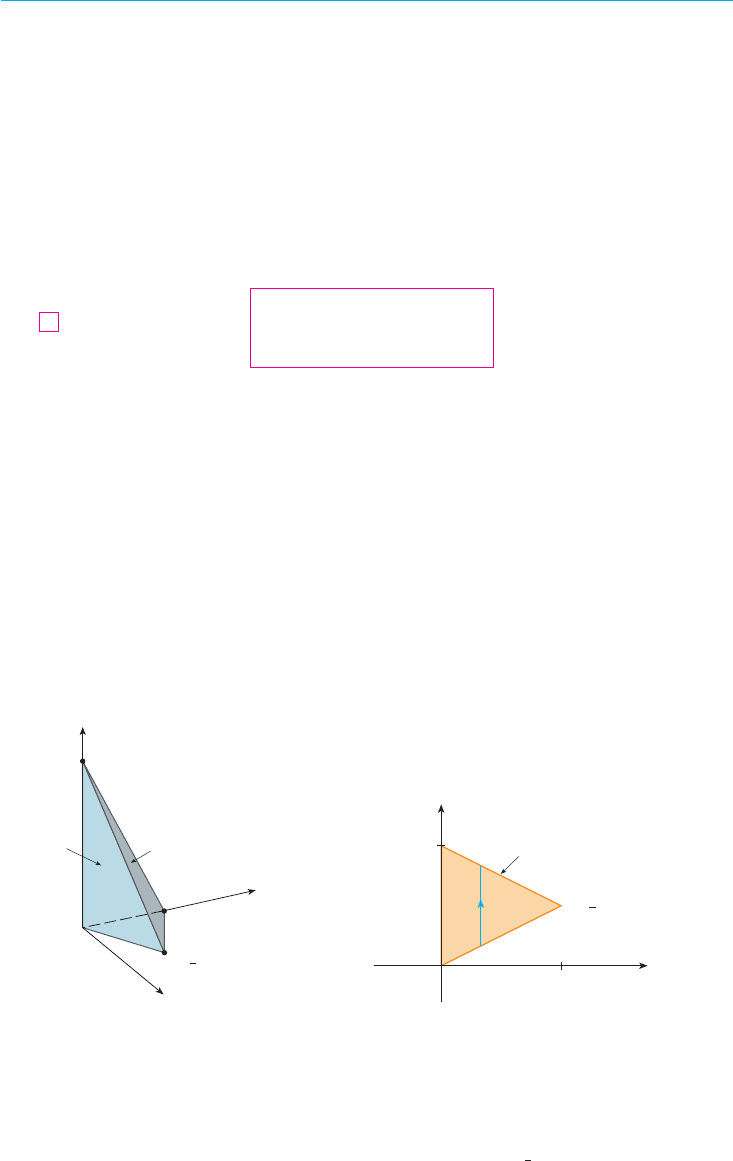
APPLICATIONS OF TRIPLE INTEGRALS
Recall that if , then the single integral represents the area under the
curve from to , and if , then the double integral rep-
resents the volume under the surface and above . The corresponding inter-
pretation of a triple integral , where , is not very useful
because it would be the “hypervolume” of a four-dimensional object and, of course, that
is very difficult to visualize. (Remember that is just the domain of the function ; the
graph of lies in four-dimensional space.) Nonetheless, the triple integral
can be interpreted in different ways in different physical situations, depending on the phys-
ical interpretations of , , and .
Let’s begin with the special case where for all points in . Then the triple
integral does represent the volume of :
For example, you can see this in the case of a type 1 region by putting in
Formula 6:
and from Section 16.3 we know this represents the volume that lies between the surfaces
and .
EXAMPLE 4 Use a triple integral to find the volume of the tetrahedron bounded by the
planes , , , and .
SOLUTION The tetrahedron and its projection on the -plane are shown in Figures 12
and 13. The lower boundary of is the plane and the upper boundary is the plane
, that is, .
Therefore we have
by the same calculation as in Example 4 in Section 16.3.
苷
y
1
0
y
1x兾2
x兾2
共2 x 2y兲 dy dx 苷
1
3
V共T兲 苷
yyy
T
dV 苷
y
1
0
y
1x兾2
x兾2
y
2x2y
0
dz dy dx
FIGURE 12
(or y=1-x/2)
FIGURE 13
y=x/2
”1, ’
1
2
D
y
0
1
x
1
x+2y=2
(0,1,0)
(0,0,2)
y
x
0
z
x+2y+z=2
x=2y
”1, ,0’
1
2
T
z 苷 2 x 2yx 2y z 苷 2
z 苷 0T
xyDT
z 苷 0x 苷 0x 苷 2yx 2y z 苷 2
T
z 苷 u
2
共x, y兲z 苷 u
1
共x, y兲
yyy
E
1 dV 苷
yy
D
冋y
u
2
共x, y兲
u
1
共x, y兲
dz
册
dA 苷
yy
D
关u
2
共x, y兲 u
1
共x, y兲兴 dA
f 共x, y, z兲 苷 1
V共E兲 苷
yyy
E
dV
12
E
Ef 共x, y, z兲 苷 1
f 共x, y, z兲zyx
xxx
E
f 共x, y, z兲 dVf
fE
f 共x, y, z兲 0xxx
E
f 共x, y, z兲 dV
Dz 苷 f 共x, y兲
xx
D
f 共x, y兲 dAf 共x, y兲 0bay 苷 f 共x兲
x
b
a
f 共x兲 dxf 共x兲 0
SECTION 16.6 TRIPLE INTEGRALS
||||
1031
